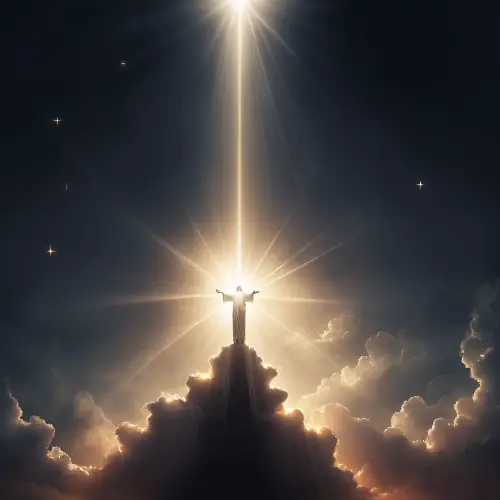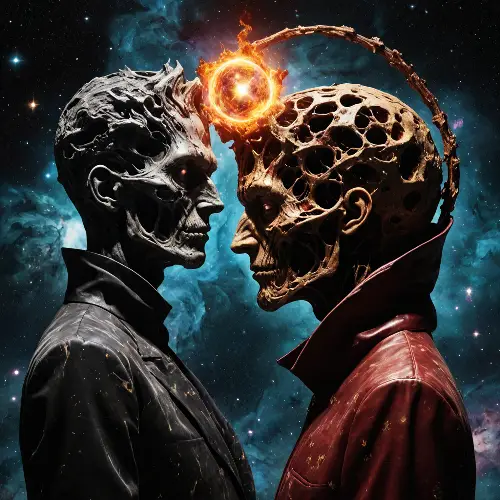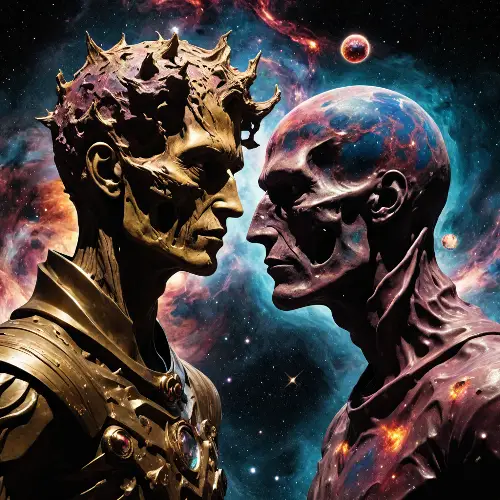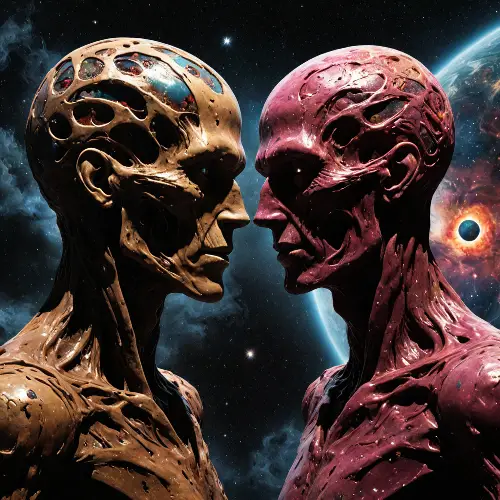Genesis 1: 1 In the beginning God created heaven, and earth. 2 And the earth was void and empty, and darkness was upon the face of the deep; and the spirit of God moved over the waters painted in the style of William-Adolphe Bouguereau
More Like This
Genesis 1: 1 In the beginning God created heaven, and earth. 2 And the earth was void and empty, and darkness was upon the face of the deep; and the spirit of God moved over the waters.
Genesis 1: 1 In the beginning God created heaven, and earth. 2 And the earth was void and empty, and darkness was upon the face of the deep; and the spirit of God moved over the waters.
In the beginning God created the heavens and the earth. 2 Now the earth was formless and empty, darkness was over the surface of the deep, and the Spirit of God was hovering over the waters. 3 And God said, “Let there be light,” and there was light. 4 God saw that the light was good, and he separated the light from the darkness. 5 God called the light “day,” and the darkness he called “night.” And there was evening, and there was morning—the first day. 6 And God said, “Let there be a vault between the waters to separate water from water.”
planet earth getting created, dust flying around, mystical shadow of god in the background, earth floating above gods hands, magical light coming out of his hands
In the beginning God creating heaven, and earth with realistic detailed faces, realistic detailed hands painted in oil on copper in the style of john turner
In the beginning God creating heaven, and earth with realistic detailed faces, realistic detailed hands painted in oil on copper in the style of jan brueghel the elder
In the beginning God creating heaven, and earth with realistic detailed faces, realistic detailed hands painted in oil on copper in the style of jan brueghel the elder
man opening the sky and splitting the earth, a flood of divine light and righteousness overtaking the earth, a shower of stars upon the earth, representing a new era of justice and peace, amidst a tumultuous environment of sudden change, portrayed with dramatic lighting and contrasts, Painting, surrealistic style with vibrant colors and contrasting textures.
In the beginning was the Word, and the Word was with God, and the Word was God. The same was in the beginning with God. All things were made by him; and without him was not any thing made that was made. In him was life; and the life was the light of men. And the light shineth in darkness; and the darkness comprehended it not.
Creating a spectacular art piece that represents the contrast of good and evil, heaven and hell, God and Satan, incorporating various materials and textures, requires careful planning and artistic skill. Here's a description of such an artwork: Title: \"Eternal Struggle: The Battle of Heaven and Hell\" Description: Medium and Materials: Canvas: The artwork is large, covering an expansive canvas to allow for intricate details. Paint: High-quality acrylic and oil paints are used to create vibrant colors and depth. Colored Pencils: Colored pencils are applied to add fine details and shading. Crayons: Wax crayons are incorporated to create texture and add a sense of chaos. Clay: Molding clay is used to sculpt three-dimensional elements in the artwork. Glass Beads: Small glass beads are attached to the canvas to add a touch of brilliance. Various Textures: Different textures are created using gels, pastes, and textured materials to enhance the tactile experience. Composition: The artwork is divided into two main sections, each representing opposing forces: Heaven: In the upper part of the canvas, Heaven is depicted as a realm of light and serenity. God, represented as a radiant figure, sits on a throne of clouds, surrounded by angels with wings outstretched. The use of soft, pastel colors and delicate brushstrokes conveys a sense of peace and harmony. Details like halos and flowing robes add to the ethereal atmosphere. Hell: In the lower part of the canvas, Hell is a chaotic and fiery abyss. Satan, portrayed as a monstrous, horned figure, reigns over the damned souls. Flames and jagged rocks create a tumultuous landscape. The colors are intense and fiery, with deep reds, oranges, and blacks dominating. Contrasts and Proximity: The stark contrast between Heaven and Hell is evident both in color and composition. Heaven's lightness sharply contrasts with Hell's darkness. God and Satan are positioned at the center of their respective realms, highlighting their roles as the central figures in this eternal struggle. The boundary between Heaven and Hell is not a clear line but a turbulent zone where the two realms meet. This transitional area represents the ongoing battle between good and evil. Details: The fine details in both realms are meticulously rendered. In Heaven, individual feathers on angelic wings and the intricate patterns on God's robe are visible. In Hell, the contorted expressions of damned souls and the grotesque features of demons are painstakingly depicted. Glass beads are incorporated to add a touch of luminosity to heavenly elements, like halos and angelic garments, while the same beads are used in Hell to represent fiery embers. Message: The artwork serves as a visual representation of the eternal struggle between good and evil, emphasizing the stark contrasts between Heaven and Hell. It invites viewers to contemplate the complexities of morality, spirituality, and the human condition. This intricate and colorful artwork, with its blend of mediums and textures, creates a visually stunning representation of a timeless theme that has intrigued and inspired artists throughout history.
Creating a spectacular art piece that represents the contrast of good and evil, heaven and hell, God and Satan, incorporating various materials and textures, requires careful planning and artistic skill. Here's a description of such an artwork: Title: \"Eternal Struggle: The Battle of Heaven and Hell\" Description: Medium and Materials: Canvas: The artwork is large, covering an expansive canvas to allow for intricate details. Paint: High-quality acrylic and oil paints are used to create vibrant colors and depth. Colored Pencils: Colored pencils are applied to add fine details and shading. Crayons: Wax crayons are incorporated to create texture and add a sense of chaos. Clay: Molding clay is used to sculpt three-dimensional elements in the artwork. Glass Beads: Small glass beads are attached to the canvas to add a touch of brilliance. Various Textures: Different textures are created using gels, pastes, and textured materials to enhance the tactile experience. Composition: The artwork is divided into two main sections, each representing opposing forces: Heaven: In the upper part of the canvas, Heaven is depicted as a realm of light and serenity. God, represented as a radiant figure, sits on a throne of clouds, surrounded by angels with wings outstretched. The use of soft, pastel colors and delicate brushstrokes conveys a sense of peace and harmony. Details like halos and flowing robes add to the ethereal atmosphere. Hell: In the lower part of the canvas, Hell is a chaotic and fiery abyss. Satan, portrayed as a monstrous, horned figure, reigns over the damned souls. Flames and jagged rocks create a tumultuous landscape. The colors are intense and fiery, with deep reds, oranges, and blacks dominating. Contrasts and Proximity: The stark contrast between Heaven and Hell is evident both in color and composition. Heaven's lightness sharply contrasts with Hell's darkness. God and Satan are positioned at the center of their respective realms, highlighting their roles as the central figures in this eternal struggle. The boundary between Heaven and Hell is not a clear line but a turbulent zone where the two realms meet. This transitional area represents the ongoing battle between good and evil. Details: The fine details in both realms are meticulously rendered. In Heaven, individual feathers on angelic wings and the intricate patterns on God's robe are visible. In Hell, the contorted expressions of damned souls and the grotesque features of demons are painstakingly depicted. Glass beads are incorporated to add a touch of luminosity to heavenly elements, like halos and angelic garments, while the same beads are used in Hell to represent fiery embers. Message: The artwork serves as a visual representation of the eternal struggle between good and evil, emphasizing the stark contrasts between Heaven and Hell. It invites viewers to contemplate the complexities of morality, spirituality, and the human condition. This intricate and colorful artwork, with its blend of mediums and textures, creates a visually stunning representation of a timeless theme that has intrigued and inspired artists throughout history.
God created extraterrestrials, the earthly domain was radiant. A painting made by (John Martin), Unique, historical, mystical (Inspired by Pandemomium)
God created extraterrestrials, the earthly domain was radiant. A painting made by (John Martin), Unique, historical, mystical (Inspired by Pandemomium)
God created extraterrestrials, the earthly domain was radiant. A painting made by (John Martin), Unique, historical, mystical (Inspired by Pandemomium)
The Dawn of CreationImagine a breathtaking scene depicting the dawn of time, captured with the utmost precision and clarity. The photo showcases the clash between the forces of hot and cold, symbolizing the birth of the universe. The main focus of the image is the ethereal beauty that emerges from this cosmic battle. The photo captures an epic moment, where the altruistic nature of creation is on full display. The colors are vibrant and dynamic, showcasing the contrast between fiery reds and icy blues. The lighting is dramatic, illuminating the scene with an otherworldly glow. The textures are smooth and fluid, representing the everchanging nature of the universe. The perspective is grand and sweeping, providing a sense of awe and wonder.Negative
On the first day, with a commanding voice, God said, \"Let there be light.\" Brightness replaced darkness, defining day and night.
The scene unfolds in a serene celestial setting. At the center lies a human figure crafted from clay, peacefully resembling sleep. Above, a divine silhouette leans towards the clay figure, composed of ethereal light, indicating its transcendental nature. Between the extended hands of the divine silhouette, a misty breath symbolizes God's exhale. This divine breath, in a gentle spiral, moves towards the clay figure. As the divine breath touches the clay, a visible transformation occurs. The clay gains texture, revealing the creation of the human form. The contours become defined, and gradually, the clay transforms into flesh and bone. A transparent human silhouette, representing the living spirit, emerges as if the divine breath has breathed life into it. This visual representation mirrors the biblical narrative where God forms man from the dust of the earth and breathes life into him.
The scene unfolds in a serene celestial setting. At the center lies a human figure crafted from clay, peacefully resembling sleep. Above, a divine silhouette leans towards the clay figure, composed of ethereal light, indicating its transcendental nature. Between the extended hands of the divine silhouette, a misty breath symbolizes God's exhale. This divine breath, in a gentle spiral, moves towards the clay figure. As the divine breath touches the clay, a visible transformation occurs. The clay gains texture, revealing the creation of the human form. The contours become defined, and gradually, the clay transforms into flesh and bone. A transparent human silhouette, representing the living spirit, emerges as if the divine breath has breathed life into it. This visual representation mirrors the biblical narrative where God forms man from the dust of the earth and breathes life into him.
The scene unfolds in a serene celestial setting. At the center lies a human figure crafted from clay, peacefully resembling sleep. Above, a divine silhouette leans towards the clay figure, composed of ethereal light, indicating its transcendental nature. Between the extended hands of the divine silhouette, a misty breath symbolizes God's exhale. This divine breath, in a gentle spiral, moves towards the clay figure. As the divine breath touches the clay, a visible transformation occurs. The clay gains texture, revealing the creation of the human form. The contours become defined, and gradually, the clay transforms into flesh and bone. A transparent human silhouette, representing the living spirit, emerges as if the divine breath has breathed life into it. This visual representation mirrors the biblical narrative where God forms man from the dust of the earth and breathes life into him.
I thought for a long time and was in doubt for a long time, What is there to look at the earth from above; Or does everything flow without order through blindness, And there is no providence from heaven in the entire universe. However, having looked at the harmony of the heavenly lights, Earth, seas and rivers kindness and decency, Change of days, nights, appearance of the moon, He recognized that we were created by divine power.
I thought for a long time and was in doubt for a long time, What is there to look at the earth from above; Or does everything flow without order through blindness, And there is no providence from heaven in the entire universe. However, having looked at the harmony of the heavenly lights, Earth, seas and rivers kindness and decency, Change of days, nights, appearance of the moon, He recognized that we were created by divine power.
I thought for a long time and was in doubt for a long time, What is there to look at the earth from above; Or does everything flow without order through blindness, And there is no providence from heaven in the entire universe. However, having looked at the harmony of the heavenly lights, Earth, seas and rivers kindness and decency, Change of days, nights, appearance of the moon, He recognized that we were created by divine power.
recreate painting \\\"The Creation of Adam\\\",god giving money to adam,oil paint,best quality
In the center of paradise, a human figure made of clay. Above, a divine silhouette leans towards the clay figure, composed of ethereal light. Hands of light touch the face of the man made of clay, a misty breath symbolizes the exhalation of God. This divine breath, in a gentle spiral, advances towards the clay figure. When the divine breath touches the clay, a visible transformation occurs. The clay gains texture, revealing the creation of the human form. The contours are defined and, little by little, the clay transforms into flesh and blood. The divine breath would have given him life. God forms man from the dust of the earth and gives him life
In the center of paradise, a human figure made of clay. Above, a divine silhouette leans towards the clay figure, composed of ethereal light. Hands of light touch the face of the man made of clay, a misty breath symbolizes the exhalation of God. This divine breath, in a gentle spiral, advances towards the clay figure. When the divine breath touches the clay, a visible transformation occurs. The clay gains texture, revealing the creation of the human form. The contours are defined and, little by little, the clay transforms into flesh and blood. The divine breath would have given him life. God forms man from the dust of the earth and gives him life
In the center of paradise, a human figure made of clay. Above, a divine silhouette leans towards the clay figure, composed of ethereal light. Hands of light touch the face of the man made of clay, a misty breath symbolizes the exhalation of God. This divine breath, in a gentle spiral, advances towards the clay figure. When the divine breath touches the clay, a visible transformation occurs. The clay gains texture, revealing the creation of the human form. The contours are defined and, little by little, the clay transforms into flesh and blood. The divine breath would have given him life. God forms man from the dust of the earth and gives him life
In the vast emptiness of the interstellar void, two omnipotent deities from separate dimensions collide. The Creator, a deity whose face is an ever-evolving canvas of galaxies and life, wields the power of creation, bringing forth stars, planets, and life forms with a wave of their hand. Opposite them stands the Destroyer, a god whose face is a shifting visage of decay and entropy, wielding the power of destruction, disintegrating celestial bodies and extinguishing stars. The clash of creation and destruction is a cosmic spectacle, with galaxies being born and dying in the wake of their unimaginable powers
In the vast emptiness of the interstellar void, two omnipotent deities from separate dimensions collide. The Creator, a deity whose face is an ever-evolving canvas of galaxies and life, wields the power of creation, bringing forth stars, planets, and life forms with a wave of their hand. Opposite them stands the Destroyer, a god whose face is a shifting visage of decay and entropy, wielding the power of destruction, disintegrating celestial bodies and extinguishing stars. The clash of creation and destruction is a cosmic spectacle, with galaxies being born and dying in the wake of their unimaginable powers
the entire book of Genesis summed up in a single image, complex, detailed
A dark and apocalyptic scene that shows the world in flames, after humanity has provoked the wrath of God by their sins and their godlessness. The only survivors are a Quaker, who desperately prays to God, and a jellyfish, who swims in an oil-polluted puddle. The spring, the burbot and the receipt are burned to ashes. The image should depict the horrors of the Last Judgment and the hopelessness of the situation. No colors except black, red and gray, No other living beings or objects except the Quaker and the jellyfish, No symbols or characters that indicate a specific religion or culture
A dark and apocalyptic scene that shows the world in flames, after humanity has provoked the wrath of God by their sins and their godlessness. The only survivors are a Quaker, who desperately prays to God, and a jellyfish, who swims in an oil-polluted puddle. The spring, the burbot and the receipt are burned to ashes. The image should depict the horrors of the Last Judgment and the hopelessness of the situation. No colors except black, red and gray, No other living beings or objects except the Quaker and the jellyfish, No symbols or characters that indicate a specific religion or culture
In the inception of the world, the gods contemplated creating beings to inhabit fertile lands
The Genesis of Duality In this vibrant opening scene, imagine a surreal canvas split in half. On one side, life blossoms with vibrant colors and erratic shapes, representing creation. On the other, darkness looms, portraying the void before existence. This masterpiece captures the essence of dualities, setting the stage for the cosmic drama to unfold.















































































